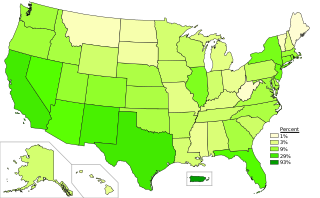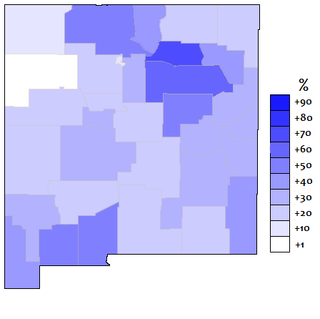Related Research Articles
Historical linguistics, also known as diachronic linguistics, is the scientific study of how languages change over time. It seeks to understand the nature and causes of linguistic change and to trace the evolution of languages. Historical linguistics involves several key areas of study, including the reconstruction of ancestral languages, the classification of languages into families,(comparative linguistics) and the analysis of the cultural and social influences on language development.

Spanglish is any language variety that results from conversationally combining Spanish and English. The term is mostly used in the United States and refers to a blend of the words and grammar of the two languages. More narrowly, Spanglish can specifically mean a variety of Spanish with heavy use of English loanwords.

Spanish is the second most spoken language in the United States. Over 43.4 million people aged five or older speak Spanish at home (13.7%). Spanish is also the most learned language other than English, with about 8 million students. Estimates count up to 58.9 million native speakers, heritage language speakers, and second-language speakers. There is an Academy of the Spanish Language located in the United States as well.

In linguistics, code-switching or language alternation occurs when a speaker alternates between two or more languages, or language varieties, in the context of a single conversation or situation. These alternations are generally intended to influence the relationship between the speakers, for example, suggesting that they may share identities based on similar linguistic histories.
Anthropological linguistics is the subfield of linguistics and anthropology which deals with the place of language in its wider social and cultural context, and its role in making and maintaining cultural practices and societal structures. While many linguists believe that a true field of anthropological linguistics is nonexistent, preferring the term linguistic anthropology to cover this subfield, many others regard the two as interchangeable.

Chicano English, or Mexican-American English, is a dialect of American English spoken primarily by Mexican Americans, particularly in the Southwestern United States ranging from Texas to California, as well as in Chicago. Chicano English is sometimes mistakenly conflated with Spanglish, which is a mixing of Spanish and English; however, Chicano English is a fully formed and native dialect of English, not a "learner English" or interlanguage. It is even the native dialect of some speakers who know little to no Spanish, or have no Mexican heritage.
Language contact occurs when speakers of two or more languages or varieties interact with and influence each other. The study of language contact is called contact linguistics. Language contact can occur at language borders, between adstratum languages, or as the result of migration, with an intrusive language acting as either a superstratum or a substratum.
A mixed language, also referred to as a hybrid language, contact language, or fusion language, is a language that arises among a bilingual group combining aspects of two or more languages but not clearly deriving primarily from any single language. It differs from a creole or pidgin language in that, whereas creoles/pidgins arise where speakers of many languages acquire a common language, a mixed language typically arises in a population that is fluent in both of the source languages.
Code-mixing is the mixing of two or more languages or language varieties in speech.

New Mexican Spanish refers to the varieties of Spanish spoken in the United States in New Mexico and southern Colorado. It includes an endangered traditional indigenous dialect spoken generally by Oasisamerican peoples and Hispano—descendants, who live mostly in New Mexico, southern Colorado, in Pueblos, Jicarilla, Mescalero, the Navajo Nation, and in other parts of the former regions of Nuevo Mexico and the New Mexico Territory.

Uruguayan Portuguese, also known as fronteiriço and riverense, and referred to by its speakers as portunhol, is a variety of Portuguese in South America with heavy influence from Rioplatense Spanish. It is spoken in north-eastern Uruguay, near the Brazilian border, mainly in the region of the twin cities of Rivera (Uruguay) and Santana do Livramento (Brazil). This section of the frontier is called "Peace Border", because there is no legal obstacle to crossing the border between the two countries.

Barranquenho is a Romance linguistic variety spoken in the Portuguese town of Barrancos, near the Spanish border. It is a mixed language, and can be considered either a variety of Portuguese heavily influenced by the Spanish dialects of neighbouring areas in Spain in Extremadura and Andalusia, or a Spanish dialect heavily influenced by Portuguese.
A language survey is conducted around the world for a variety of reasons.

Shana Poplack, is a Distinguished University Professor in the linguistics department of the University of Ottawa and three time holder of the Canada Research Chair in Linguistics. She is a leading proponent of variation theory, the approach to language science pioneered by William Labov. She has extended the methodology and theory of this field into bilingual speech patterns, the prescription-praxis dialectic in the co-evolution of standard and non-standard languages, and the comparative reconstruction of ancestral speech varieties, including African American vernacular English. She founded and directs the University of Ottawa Sociolinguistics Laboratory.
Virginia Yip (葉彩燕), is a Hong Kong linguist and writer. She is director of the Childhood Bilingualism Research Centre. She is a professor at the Chinese University of Hong Kong. Her research interests include bilingual language acquisition, second language acquisition, Cantonese, Chaozhou and comparative Sinitic grammar, psycholinguistics, and cognitive science.
Ana Maria Carvalho is a Brazilian sociolinguist and a professor of linguistics within the Department of Spanish and Portuguese at the University of Arizona. She is the author of several books and articles on sociolinguistics and language acquisition.
John M. Lipski is an American linguist who is most widely known for his work on Spanish and Portuguese dialectology and variation. His research also focuses on Spanish phonology, the linguistic aspects of bilingualism and code-switching, African influences on Spanish and Portuguese, and pidgin and creole studies. He is currently the Edwin Erle Sparks Professor of Spanish Linguistics in the Department of Spanish, Italian, and Portuguese at the Pennsylvania State University. He previously served as the head of the same department from 2001 to 2005.
Carmen Silva-Corvalán is a Professor Emerita of Spanish and Portuguese Linguistics at the University of Southern California, where she taught since she obtained her doctoral degree at the University of California, Los Angeles in 1979. Silva-Corvalán has published extensively on bilingualism and language contact, and on the semantic and discourse-pragmatic constraints which condition syntactic variation. Silva-Corvalan was one of the four chief editors of Bilingualism: Language and Cognition, Cambridge University Press.
The bibliography of code-switching comprises all academic and peer-reviewed works on the topic of code-switching. It is sorted by category, then alphabetically.
María Dolores Gonzales is a Mexican-American author and educator, and advocate for bilingual education in the US. She is a scholar in the realm of bilingual studies and linguistic history of the American Southwest. She taught at University of New Mexico for 12 years as a professor and was head of the Sabine Ulibarrí Spanish Heritage Program, and after retiring established the Spanish immersion program, Bilingual Strategies. Her programs advocate for the revitalization of New Mexican Spanish and dialectical awareness to connect Spanish speakers with their heritage, in order to reverse the damage of Spanish and US colonialism.
References
- ↑ Gutierrez-Rexach, J (2003). "Review of Grammaticization, Synchronic Variation, and Language Contact. A Study of Spanish Progressive-Constructions". Studies in Language. John Benjamins Publishing. doi:10.1075/sl.27.1.14gut.
- ↑ "Rene Torres Cacoullos - Google Scholar". scholar.google.com. Retrieved 2021-12-30.
- ↑ "Rena Torres Cacoullos – Center for Language Science" . Retrieved 2021-12-30.
- ↑ "alumni - UNM, Hispanic Linguistics". www.unm.edu. Retrieved 2021-12-30.
- ↑ Nguyen, Li (2019). "Review : Torres Cacoullos and Travis. 2018. Bilingualism in the Community : Code-switching and Grammars in Contact . Cambridge: Cambridge University Press". Theoretical and Applied Linguistics. 14 (2): 265–269. doi:10.3366/cor.2019.0171. ISSN 1749-5032. S2CID 201901102.
- ↑ "Editorial board - Language Variation and Change". Cambridge Core. Retrieved 2021-12-30.
- ↑ "Linguistic Society of America List of Fellows by Year" . Retrieved 11 March 2022.